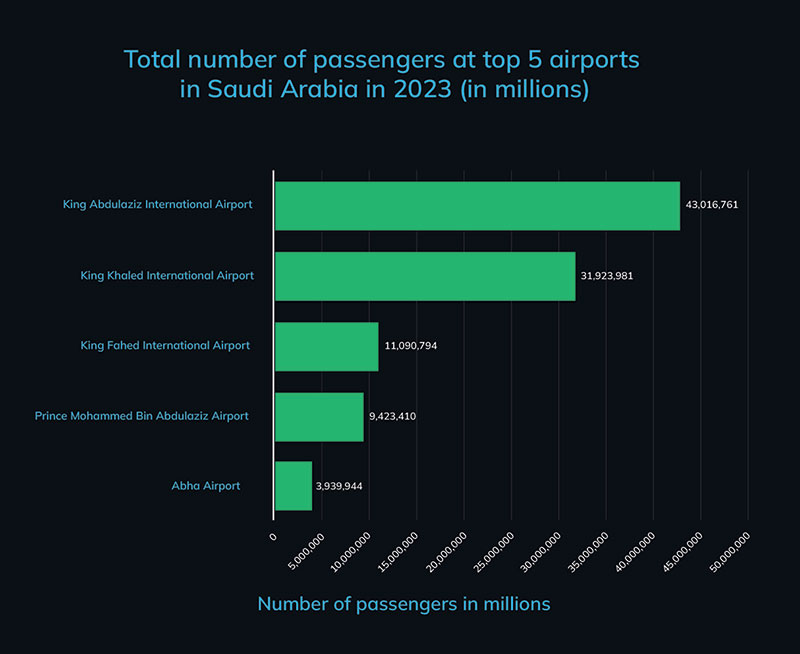Saudi Arabia’s aviation sector is undergoing a significant transformation, driven by the Vision 2030 initiative. The General Authority of Civil Aviation (GACA) has implemented reforms to enhance competitiveness and attract investment, aiming to mobilize $100 billion by 2030. Passenger traffic has surged, with a 26% increase in 2023 compared to 2022. The sector’s growth is supported by streamlined regulations, including the removal of economic license requirements for charter flights and the expansion of qualifying rules for airport operators. These changes are designed to boost the sector’s contribution to GDP, create jobs, and support economic diversification. The following airports serve as major aviation hubs in Saudi Arabia, facilitating both passenger and cargo operations:
- King Abdulaziz International Airport (Jeddah) (IATA Code: JED, ICAO Code: OEJN)
- King Khalid International Airport (Riyadh) (IATA Code: RUH, ICAO Code: OERK)
- King Fahd International Airport (Dammam) (IATA Code: DMM, ICAO Code: OEDF)
- Prince Mohammed Bin Abdulaziz International Airport (Medina) (IATA Code: MED, ICAO Code: OEMA)
- Abha International Airport (Abha) (IATA Code: AHB, ICAO Code: OEAB)

International Flight Operations at King Abdulaziz International Airport (JED)
King Abdulaziz International Airport (JED) features three main terminals:
- Terminal 1: The largest terminal, handling most domestic and international flights, with amenities including shops, restaurants, lounges, and an airside hotel.
- North Terminal: Used primarily by non-Saudi airlines and supports additional international flights during Hajj and Umrah seasons.
- Hajj Terminal: Designed for the annual Hajj pilgrimage, featuring a distinctive tent-like roof and facilities such as a souk, mosque, and dining areas.
King Abdulaziz International Airport has three runways. Runway 16C/34C is the longest, with a length of 4,000 meters (13,123 feet) and a paved surface. Runway 16L/34R and Runway 16R/34L both have a length of 3,299.5 meters (10,825 feet) and are surfaced with concrete. These runways support the airport’s high volume of air traffic, accommodating a variety of aircraft types and ensuring efficient operations.
Airport Type: 24-hour airport, primarily a destination, also suitable for tech stops.
Turn Time: Approximately one hour for tech stops.
Landing Permits:
- Required for both private non-revenue and charter flights.
- Lead time: Minimum of three days for regular requests.
- Weekend Requests: Minimum of five days required if requested over the weekend.
- Sponsor: A sponsor is needed for landing permit applications. The Civil Aviation Authority (CAA) will verify the sponsor’s details.
- Exception: No landing permit required for tech stops only.
PPR/Slots: No PPR (Prior Permission Required) or airport slots needed.
Equipment Support: Full Ground Handling Equipments (GSEs) are available through Just Aviation’s coordination.
GACA Regulations for Landing at King Abdulaziz International Airport (JED)
- Regulatory Authority: General Authority of Civil Aviation (GACA) enforces strict regulations for aircraft intending to land at OEJN (JED).
- Compliance: Must comply with ICAO standards and GACA-specific guidelines.
- Prior Permission:
- Permission required via the GACA e-Services portal.
- Application Lead Time: Must be submitted at least 72 hours in advance.
- Validity: Applications are valid for specific flights or defined periods.
- Required Documents:
- Air Operator Certificate (AOC).
- Aircraft Registration and Airworthiness Certificates.
- Proof of insurance.
- Detailed flight plans.
- Crew licenses.
- Passenger and cargo manifests.
- Operational Compliance:
- Adherence to noise abatement procedures.
- Slot coordination.
- Strict security protocols.
- Application Review: GACA typically reviews applications within 24-48 hours. Approval status is communicated via the portal.
Jet A-1 Fuel prices in Saudi Arabia are attractive, with King Abdulaziz International Airport (JED) and King Khalid International Airport (RUH) being popular options. It’s important to carry a fuel release, ensure fuel credit is pre-organized, and provide at least 24-hour notice for uplifts at major airports, or 72 hours at smaller locations.
International Flight Operations at King Khalid International Airport (RUH)
King Khalid International Airport (RUH) has five terminals. Terminal 1 and Terminal 2 are primarily used for international flights. Terminal 3, recently renovated, also serves international flights, as does Terminal 4, which was launched alongside Terminal 3. Terminal 5 is a newer addition, focusing on domestic flights.
King Khalid International Airport features two parallel runways. Both Runway 15R/33L and Runway 15L/33R have a length of 4,205 meters (13,796 feet) and are surfaced with asphalt, allowing for efficient and safe aircraft operations.
Landing Permits for King Khalid International Airport (RUH)
- Permit Application: Must be submitted at least 24 hours before arrival (72 hours recommended).
- Documents Required: General Declaration of crew and passengers, receiving party details, Airworthiness Review, Registration Certificates, valid insurance, noise certification, and Air Operator Certificate.
- Compliance: Operators must comply with GACA’s routing and operational requirements. Changes to flight plans require prior approval.
- Permit Validity: Landing permits are valid only for the approved date and time; adherence to the schedule is critical to avoid operational disruptions.
Operational Insights for OERK (King Khalid International Airport)
- Two Runways Open 24 Hours: Ensure slot coordination for efficient movement as both runways are available for operations around the clock.
- R60 Slot Capacity Limit (Full W24 Season): Plan for up to 35 movements per hour (20 arrivals, 15 departures) within peak periods.
- R15 Slot Capacity Limit (Full W24 Season): During low-demand times, up to 9 movements per hour (5 arrivals, 4 departures) are possible.
- Aircraft Parking Inventory:
- Terminal 1: Closed for rehabilitation.
- Terminal 2, 3 & 4: 6 stands (up to Code C/E).
- Terminal 5: 16 stands (up to Code C, 8 Code E).
- Remote parking available with varying stand types (Code C/E/D).
- Remote Parking: Limited availability at West Remote (8 stands up to Code C) and East Remote (3 stands).
- Apron 6: Has 34 stands for Code C or 20 for Code E; useful for overflow parking.
- Cargo Apron: Space for up to 9 Code C, 7 Code E, or 6 Code F stands; plan accordingly for freight flights.
- ICAO Code F Aircraft: Not permitted, plan operations accordingly for aircraft within allowed code range.
- Technical Stops: Not allowed at OERK; ensure alternate arrangements if needed.
- Training Flights: Require prior approval from the airport authority, so request approval early.
- Freight Flight Separation: A 45-minute gap is required between each freight flight, so adjust schedules accordingly.
- GABA Scheduled Slot Requests: Managed by ACL, so ensure timely slot requests to avoid delays.
Slot Coordination and Regulations for Saudi Arabia International Flight Operations
Saudi Arabian international airports follow strict slot coordination and regulatory guidelines for both scheduled and non-scheduled flight operations:
Scheduled Flight Operations
Slot coordination for scheduled flights across Saudi Arabia’s international airports is managed by Airport Coordination Limited (ACL) and governed by the General Authority of Civil Aviation (GACA) under the Economic Regulations. Peak times typically occur during the Hajj season (June to August) and at the end of Ramadan, with additional peak hours in the early mornings (6 AM – 9 AM) and late evenings (6 PM – 9 PM).
Non-Scheduled Flight Operations (Business Purpose Flights)
For non-scheduled flights, slot coordination is also handled by ACL, with specific guidelines from GACA for these operations. Peak times mirror those of scheduled flights, with added surges during major business events and conferences.
Important Regulations
- General Regulations: All flights must comply with the Civil Aviation Law of Saudi Arabia.
- Noise Restrictions: Adherence to noise abatement procedures is mandatory.
- Environmental Regulations: Compliance with environmental protection guidelines is required.
- Security Regulations: Strict security protocols, including passenger and cargo screening, must be followed.
Required Documents
For both scheduled and non-scheduled flight operations, the following documents are typically required:
- Air Operator Certificate (AOC)
- Insurance Certificate
- Aircraft Registration Certificate
- Noise Certificate
- Operations Specifications
- Flight Plan
- Crew Licenses and Medical Certificates
- Maintenance Release
- Passenger and Cargo Manifest
To ensure smooth operations and avoid delays, feel free to collaborate with Just Aviation team during the planning phase. We can help navigate regulatory requirements, secure necessary slots, and address any potential issues before they arise, ensuring a seamless and efficient flight operation.
Overflight Permits for Saudi Arabia Airspace
Aircraft intending to fly over Saudi Arabian airspace must obtain prior permission from the General Authority of Civil Aviation (GACA), which is mandatory for both commercial and private flights. The application process requires submitting detailed information, including aircraft registration, flight itinerary, and the purpose of the flight. Additionally, operators must ensure that all necessary documentation is submitted, such as airworthiness, registration, and insurance certificates, along with other key documents. Compliance with ICAO standards is required, and a detailed flight plan must be submitted to the relevant Air Traffic Services (ATS) units at least 24 hours before departure.
Aircraft must maintain continuous communication with Saudi Arabian Air Traffic Control (ATC) while in the airspace, following assigned frequencies and reporting positions as required. In case of emergency, pilots must notify ATC immediately and adhere to standard ICAO emergency procedures. Overflight fees are applicable, based on the aircraft’s maximum takeoff weight (MTOW) and distance flown within Saudi airspace.
Required Documentation
- Airworthiness Certificate
- Registration Certificate
- Insurance Certificate (covering third-party liability)
- Noise Certificate
- Radio License
- Crew Licenses and Medical Certificates
Saudi Arabia International Airports Ground Handling Operations
Just Aviation delivers comprehensive ground handling solutions at the busiest airports in Saudi Arabia, including JED, RUH, DMM, MED, and AHB, meticulously designed for private and corporate aviation. Our services encompass ramp handling, including precision aircraft marshaling, coordinated pushback procedures, efficient refueling, aircraft towing, and more. We also provide passenger and crew support, such as expedited customs clearance, baggage handling, and access to exclusive VIP lounges.
We ensure efficient turnaround times through highly coordinated aircraft handling, utilizing all Ground Service Equipments (GSEs) to minimize delays. Our operations emphasize seamless coordination with the ground handling team and flight crew to deliver smooth and timely services.
In addition to ground handling, Just Aviation specializes in slot coordination, ensuring optimal aircraft sequencing and minimizing taxiing delays at high-density airports. We liaise directly with airport authorities and air traffic control to secure and manage slots, optimizing turnaround times and operational efficiency. Our team also facilitates essential flight permits, such as overflight and landing clearances, ensuring strict adherence to local and international aviation regulations for uninterrupted operations.
